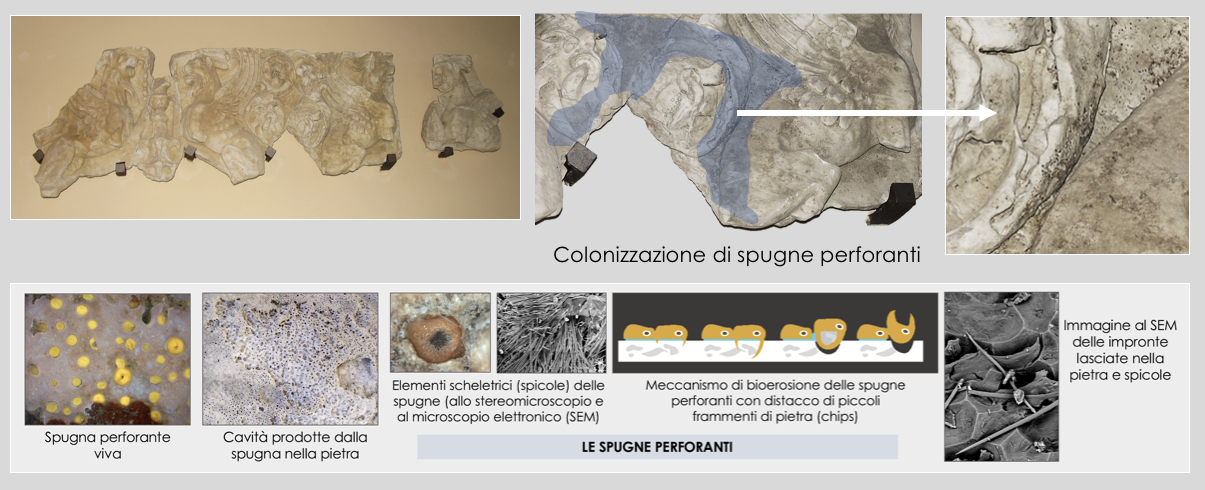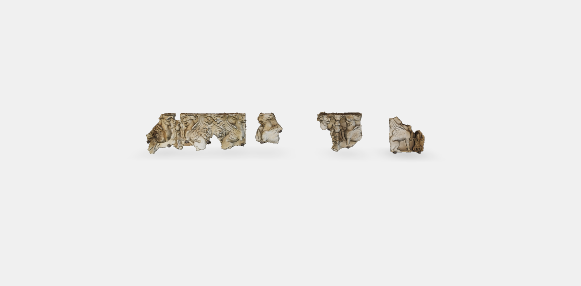A long frieze in white marble with bluish veins, featuring a series of facing griffins, was found in numerous fragments in 1924 among the remains of the sunken imperial palace in the waters of the port of Baia.
The architectonic decorations adorned the upper part of the maritime Nymphaeum from the Severan age. In all likeness, this structure was originally built in the I century A.D. during the Flavian age, while the renovation can be dated back to the III century A.D.
The motif recurs in Roman architecture, especially in the architrave of Aula Regia at the Palatine, held at the Museum of Naples.
The frieze shows a limited biological colonisation as shown by tiny holes, caused by an initial development of boring sponges, probably of the species of Cliona (see the image below).

Davidde B., Ricci S., Poggi D., Bartolini M., 2010. Marine bioerosion of stone artefacts preserved in the Museo Archeologa
Davidde B., Ricci S., Poggi D., Bartolini M., 2010. Marine bioerosion of stone artefacts preserved in the Museo Archeologico dei Campi Flegrei in the Castle of Baia (Naples), Archaeologia Maritima Mediterranea; 7: 75-115.
Maniscalco, F. 1995, ‘Un ninfeo severiano nelle acque del porto di Baia’, Ostraka, 4(2), pp. 269-270.
Maniscalco, F. 1997, Ninfei ed edifici marittimi severiani del Palatium imperiale di Baia. Napoli: Massa Editore, pp. 44-46.
Napoli, M. 1953 ‘Di una villa marittima di Baia’, Bollettino di Storia dell’Arte. Istituto Universitario di Magistero, Salerno, III(1), pp. 100-101.
Ricci S., Sacco Perasso C., Antonelli, F., Davidde Petriaggi B., 2015. Marine Bivalves colonizing roman artefacts recovered in the Gulf of Pozzuoli and in the Blue Grotto in Capri (Naples, Italy): boring and nestling species. International Biodeterioration & Biodegradation (98) 89 – 100.
Ricci, S., Pietrini, A. M., Bartolini, M., Sacco Perasso, C., 2013. Role of the microboring marine organisms in the deterioration of archaeological submerged lapideous artifacts (Baia, Naples, Italy). International Biodeterioration & Biodegradation 82 (2013) 199-206.
Ricci S., Davidde B., Bartolini M., Priori G. F., 2009. Bioerosion of lapideous objects found in the underwater archaeological site of Baia (Naples). Archaeologia Maritima Mediterranea, 6: 167-188.
Zevi F. (cur.) 2009, Museo archeologico dei Campi Flegrei. Castello di Baia. Napoli: Electa Napoli, vol. 3, p. 130.
ico dei Campi Flegrei in the Castle of Baia (Naples), Archaeologia Maritima Mediterranea; 7: 75-115.
Ricci S., Sacco Perasso C., Antonelli, F., Davidde Petriaggi B., 2015. Marine Bivalves colonizing roman artefacts recovered in the Gulf of Pozzuoli and in the Blue Grotto in Capri (Naples, Italy): boring and nestling species. International Biodeterioration & Biodegradation (98) 89 – 100.
Ricci, S., Pietrini, A. M., Bartolini, M., Sacco Perasso, C., 2013. Role of the microboring marine organisms in the deterioration of archaeological submerged lapideous artifacts (Baia, Naples, Italy). International Biodeterioration & Biodegradation 82 (2013) 199-206.
Ricci S., Davidde B., Bartolini M., Priori G. F., 2009. Bioerosion of lapideous objects found in the underwater archaeological site of Baia (Naples). Archaeologia Maritima Mediterranea, 6: 167-188.
Zevi F. (cur.) 2009, Museo archeologico dei Campi Flegrei. Castello di Baia. Napoli: Electa Napoli, p. 139.



